Meaning
is a component of the word through which a concept is communicated
and giving to word the ability of denoting real affects, qualities,
actions and abstract notions. Inner form of the word, its meaning,
presents the semantic
str-re
of the word. The leading semantic component in the semantic structure
of a word is usually termed denotative
component or
denotation. It expresses the notional content of a word and define
its main meaning. But in order to get a sufficiently clear picture of
what the word really means we must take into consideration the
additional meaning the word possesses — the connotative
component
or connotation which may be emotive,
evaluative (positive or negative), of duration, of cause.
A word having several meanings is called polycemantic
and
the majority of English words are polys-c. The ability of words to
have more than one meaning is polysemy.
The wealth of expressive resources of a lang. depends on the degree
to which polysemy has developed in the it. The number of sounds
combinations that human speech organs can produce is limited and at a
certain stage of lang. development the production of new words by
morphemic means becomes limited. Here polysemy becomes increasing
important in providing the means for enriching the vocabulary. The
complicated process of polysemy development involves both the
appearance of new meanings and the loss of old ones. As a result of
polysemy there are cases of misunderstanding when a word is used in a
certain meaning but accepted by listener in another. In such way a
lot of jokes are made. Here the context
is a powerful preventative against confusion in meanings (a
dull razor, a dull student, a dull book/ bright color, bright metal,
bright face).
21. Lexicology as a brunch of linguistics. A word. Main lexicological problems .
Lexicology
is a branch of linguistics studying the word — a unit of speech which
due to its meanings serves the purpose of human communication, it’s
the total of the sounds comprising it. Structurally the word
possesses several characteristics, such as the external and the
internal structures. By external
structure we mean its morphol. str-re. (post
—
grad
uate
s).The
internal
str-e of the word, or its meaning, is referred to as the word’s
semantic
structure, consisting
of denotative and connotative components.
Another structural aspect of the word is its unity.
The word has external
(or formal) and semantic
unity. The formal
unity of the word can best be illustrated by comparing a word and a
word-group with identical constituents. The difference between a
redbreast and
a
red
breast
is best explained by their relationship with the grammatical system
of the language. The word redbreast,
which
is characterized by unity, possesses a single grammatical framing:
redbreast.
In the word-group a
red breast
each constituent can have grammatical forms of its own. Acc. to
semantic
unity in the word-group a
red breast each
of the meaningful words conveys a separate concept, but the word
redbreast
conveys
only one concept: the type of bird. Two of the main lexicological
problems
have already been staffed. The problem of word-building
is
associated with processes of making new words. Semantics
is the study of meaning. Modern approaches to this problem are
characterized by two different level of study: syntagmatic
and paradigmatic.
On
the syntagmatic
level,
the semantic structure of the word is analyzed in its immediate
relations with neighboring words, on the paradigmatic
level — in its relations with other words in the vocabulary system
(similar
meaning (work — labour) opposite meaning (to accept – to reject),
different characteristics (man – chap – guy)).
The main problems of paradigmatic studies are synonymy, antonymy and
functional styles. Phraseology
is the branch of lexicology specializing in word-group, which are
characterized by stability of structure and transferred meaning
(birds
of a feather-одного поля ягода).
Also lexicology studies the vocabulary of a language as a system
(diachronically and synchronically).
Соседние файлы в предмете [НЕСОРТИРОВАННОЕ]
- #
- #
- #
- #
- #
- #
- #
- #
- #
- #
- #
Скачать материал

Скачать материал


- Сейчас обучается 396 человек из 63 регионов


- Сейчас обучается 268 человек из 64 регионов




Описание презентации по отдельным слайдам:
-
1 слайд
Aspects of Lexical Meaning
Lecture -
2 слайд
ASPECTS OF LEXICAL MEANING
THE DENOTATIONAL ASPECT
THE CONNOTATIONAL ASPECT
THE PRAGMATIC ASPECT
COMPONENTIAL ANALYSIS -
3 слайд
1. THE DENOTATIONAL ASPECT
The denotational aspect of lexical meaning is the part of lexical meaning which establishes correlation between the name and the object, phenomenon, process or characteristic feature of concrete reality (or thought), which is denoted by the given word.
e.g. booklet — ‘a small thin book that gives information about something’ -
4 слайд
Through the denotational aspect of meaning the bulk of information is conveyed in the process of communication.
The denotational aspect of lexical meaning:
expresses the notional content of a word.
is the component of the lexical meaning that makes communication possible. -
5 слайд
2. THE CONNOTATIONAL ASPECT
The connotational aspect of lexical meaning is the part of meaning which reflects the attitude of the speaker towards what he speaks about. Connotation conveys additional information in the process of communication.
-
6 слайд
Connotation includes:
The emotive charge is one of the objective semantic features proper to words as linguistic units and forms part of the connotational component of meaning, e.g. daddy as compared to father.
a hovel – ‘a small house or cottage’ – implies a miserable dwelling place, dirty, in bad repair and in general unpleasant to live in. -
-
8 слайд
Evaluation, which may be positive or negative, e.g.
clique (a small group of people who seem unfriendly to other people) as compared to group (a set of people);
celebrated (widely known for special achievement in science, art, sport, etc.) as compared to notorious (widely known for criminal act or bad traits of character). -
9 слайд
Imagery:
to wade – to walk with an effort (through mud, water or anything that makes progress difficult). The figurative use of the word gives rise to another meaning, which is based on the same image as the first – to wade through a book ; -
10 слайд
intensity/expressiveness, e.g. to adore – to worship – to love – to like;
connotation of cause, duration etc. -
-
-
-
14 слайд
Thus, a meaning can have two or more connotational components.
The given examples present only a few: emotive, evaluative connotations, and also connotations of duration and of cause. -
15 слайд
3. Examples of different types of Connotation
I. The connotation of degree or intensity
to surprise — to astonish — to amaze — to astound;
to satisfy — to please — to content — to gratify — to delight — to exalt;
to shout — to yell — to bellow — to roar; to like — to admire — to love — to adore — to worship -
16 слайд
II. Connotation of duration
to stare — to glare — to gaze — to glance — to peep — to peer;
to flash (brief) — to blaze (lasting);
to shudder (brief) — to shiver (lasting);
to say (brief) — to speak, to talk (lasting). -
17 слайд
III. Emotive connotations
to stare — to glare — to gaze;
alone — single — lonely — solitary;
to tremble — to shiver — to shudder — to shake;
to love — to admire — to adore — to worship;
angry — furious — enraged;
fear — terror — horror. -
18 слайд
IV. The evaluative connotation
well-known — famous — notorious — celebrated;
to produce — to create — to manufacture — to fabricate;
to sparkle — to glitter;
A.His (her) eyes sparkled with amusement, merriment, good humour, high spirits, happiness, etc. (positive emotions).
B.His (her) eyes glittered with anger, rage, hatred,
malice, etc. (negative emotions). -
19 слайд
V. Causative connotation
to sparkle — to glitter;to shiver — to shudder;
to blush — to redden.
-
20 слайд
VI. Connotation of Manner
to stroll — to stride — to trot — to pace — to swagger — to stagger — to stumble;
to peep — to peer;
to like — to admire — to love — to adore — to worship. -
21 слайд
VII. The connotation of attendant circumstances
One peeps at smb./smth. through a hole, crack or opening, from behind a screen, a half-closed door, a newspaper, a fan, a curtain, etc. It seems as if a whole set of scenery were built within the word’s meaning. It is not quite so, because «the set of scenery» is actually built in the context, but, as with all regular contexts, it is intimately reflected in the word’s semantic structure. -
22 слайд
One peers at smb./smth. in darkness, through the fog, through dimmed glasses or windows, from a great distance; a short-sighted person may also peer at things. So, in the semantic structure of to peer are encoded circumstances preventing one from seeing clearly.
-
23 слайд
VII. Connotation of attendant features
Pretty – handsome – beautiful;
special types of human beauty:
beautiful is mostly associated with classical features and a perfect figure;
handsome with a tall stature, a certain robustness and fine proportions,
pretty with small delicate features and a fresh complexion. -
24 слайд
IX. Stylistic connotations
(Meal). Snack, bite (coll.), snap (dial.), repast, refreshment, feast (formal).
These synonyms, besides stylistic connotations, have connotations of attendant features.
Snack, bite, snap all denote a frugal meal taken in a hurry; refreshment is also a light meal; feast is a rich or abundant meal.
(Girl). Girlie (coll.), lass, lassie (dial.), bird, birdie, jane, fluff, skirt (sl.), maiden (poet.), damsel (arch.). -
25 слайд
Anecdote
J a n e: Would you be insulted if that good-looking stranger offered you some champagne?
J o a n: Yes, but I’d probably swallow the insult. -
26 слайд
3. THE PRAGMATIC ASPECT
The pragmatic aspect is the part of lexical meaning that conveys information on the situation of communication. Like the connotational aspect, the pragmatic aspect falls into four closely linked together subsections. -
27 слайд
1. Information on the ‘time and space’ relationship of the participants
Some information which specifies different parameters of communication may be conveyed not only with the help of grammatical means (tense forms, personal pronouns, etc), but through the meaning of the word.
E.g. come and go can indicate the location of the speaker who is usually taken as the zero point in the description of the situation of communication -
28 слайд
The time element is fixed indirectly. Indirect reference to time implies that the frequency of occurrence of words may change with time and in extreme cases words may be out of use or become obsolete.
E.g.the word behold – ‘take notice, see (smth unusual)’ as well as the noun beholder – ‘spectator’ are out of use now but were widely used in the 17th century. -
29 слайд
2. Information on the participants and the given language community;
The language used may be indicative of the social status of a person, his education, profession, etc.
The pragmatic aspect of the word may convey information about the social system of the given language community, its ideology, religion, system of norms and customs.
a) They chucked a stone at the cops, and then did a bunk with the loot.
b) After casting a stone at the police, they absconded with the money. -
30 слайд
3. Information on the tenor of discourse
The tenors of discourse reflect how the addresser (the speaker or the writer) interacts with the addressee (the listener or reader).
Tenors are based on social or family roles of the participants of communication.
1. Don’t interrupt when your mother is speaking (family roles).
2. There is an awful man in the front row, who butts in whenever you pause (social roles). -
31 слайд
4. Information on the register of communication
The conditions of communication form another important group of factors. The register defines the general type of the situation of communication grading the situations in formality. Three main types of the situations of communication: formal, neutral and informal.
I’m sorry if upset you, dear. I certainly didn’t mean to (informal).
There are certain qualities in his works that I greatly admire (formal).
Who is the girl I saw you with yesterday? (neutral). -
32 слайд
LEXICAL MEANING
Denotational Connotational Pragmatic aspect aspect aspectEmotive charge
Evaluation
Imagery
Intensity
Connotation
Information on the
‘time and space’
Information on the participants and
the givenlanguage community
Information on the tenor of discourse
Information on the register of communication -
33 слайд
IV. Componential analysis = semantic decomposition
rests upon the thesis that the sense of every lexeme can be analyzed in terms of a set of more general sense components or semantic features, some or all of which will be common to several different lexemes in the vocabulary.
-
34 слайд
Componential analysis
attempts to treat components according to ‘binary’ opposition:
male/ female,
animate/ inanimate,
adult/ non-adult,
human/ non-human.
The sense of man might be held to combine the concepts (male, adult, human).
The sense of woman might be held to differ from man in that it combines (female (not male), adult, human). -
35 слайд
Componential analysis allows us to group entities into natural classes.
man and boy (human, male),
man and woman (human, adult).
There are certain verbs, such as marry, argue, that are found with subjects that are [+human]. Moreover, within the English pronoun system, he is used to refer to [human] entities that are [+male] while she is used for [human] entities that are [not male]. -
36 слайд
Componential analysis of the word ‘bachelor’
According to the dictionary it has 4 meanings:a man who has never married (холостяк);
a young knight (рыцарь);
someone with a first degree (бакалавр);
a young male unmated fur seal (морской котик) during the mating season. -
37 слайд
Bachelor
Noun
(Human) (Animal)
(Male) [who has the first of (Male)
lowest academic degree][who has [young knight serving [young fur seal when
never married] under the standard of without a mate during
another knight] the breeding time][who has never [young knight serving [young fur seal when
married] under the standard of without a mate during
another knight] the breeding time] -
38 слайд
The old bachelor finally died.
‘Bachelor’ is not the fur seal (they are young).
(young) => is a marker not the distinguisher.
Theoretically there is no limit to the number of markers.
Markers refer to the features which the lexeme has in common with other lexical items,
a distinguisher differentiates it from all other items.
Distinguishers can be regarded as providing a denotational distinction, while semantic markers represent conceptual components of the meaning of lexical items. -
39 слайд
Componential analysis
gives its most important results in the study of verb meaning, it is an attractive way of handling semantic relations. It is currently combined with other linguistic procedures used for the investigation of meaning. -
40 слайд
References:
Зыкова И.В. Практический курс английской лексикологии. М.: Академия, 2006. – С.- 18-21.
Гинзбург Р.З. Лексикология английского языка. М.: Высшая школа, 1979. – С.- 20-22.
Бабич Н.Г. Лексикология английского языка. Екатеринбург-Москва. 2006. – С.- 61- 62.
Антрушина Г.Б., Афанасьева О.В., Морозова Н.Н. Лексикология английского языка. М.; Дрофа, 2006. С. — 136-142.
Найдите материал к любому уроку, указав свой предмет (категорию), класс, учебник и тему:
6 210 029 материалов в базе
- Выберите категорию:
-
Выберите учебник и тему
- Выберите класс:
-
Тип материала:
-
Все материалы
-
Статьи
-
Научные работы
-
Видеоуроки
-
Презентации
-
Конспекты
-
Тесты
-
Рабочие программы
-
Другие методич. материалы
-
Найти материалы
Другие материалы
- 31.12.2020
- 3011
- 0
- 31.12.2020
- 3821
- 2
- 31.12.2020
- 4360
- 0
- 31.12.2020
- 5233
- 10
- 31.12.2020
- 4100
- 1
- 31.12.2020
- 3975
- 1
- 31.12.2020
- 5041
- 1
- 31.12.2020
- 4290
- 41
Вам будут интересны эти курсы:
-
Курс повышения квалификации «Основы местного самоуправления и муниципальной службы»
-
Курс профессиональной переподготовки «Организация и предоставление туристских услуг»
-
Курс повышения квалификации «Организация практики студентов в соответствии с требованиями ФГОС юридических направлений подготовки»
-
Курс повышения квалификации «Разработка бизнес-плана и анализ инвестиционных проектов»
-
Курс повышения квалификации «Источники финансов»
-
Курс профессиональной переподготовки «Организация системы менеджмента транспортных услуг в туризме»
-
Курс профессиональной переподготовки «Политология: взаимодействие с органами государственной власти и управления, негосударственными и международными организациями»
-
Курс профессиональной переподготовки «Теория и методика музейного дела и охраны исторических памятников»
-
Курс профессиональной переподготовки «Организация процесса страхования (перестрахования)»
-
Курс профессиональной переподготовки «Информационная поддержка бизнес-процессов в организации»
-
Курс профессиональной переподготовки «Гражданско-правовые дисциплины: теория и методика преподавания в образовательной организации»
- Размер: 782 Кб
- Количество слайдов: 40
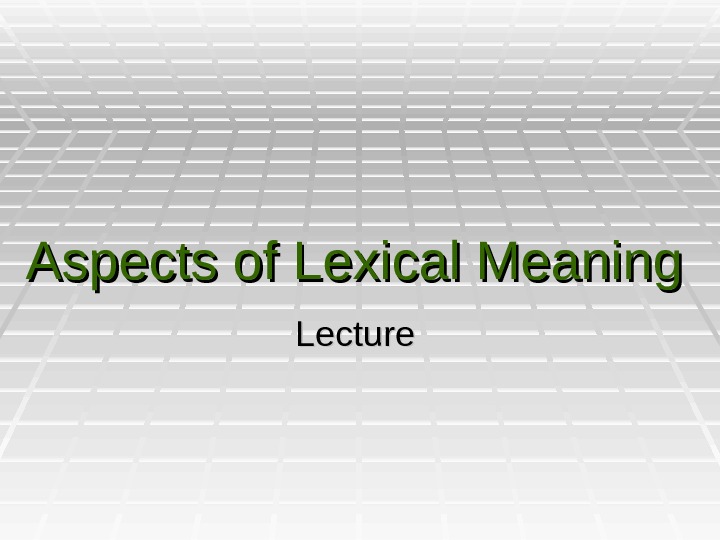

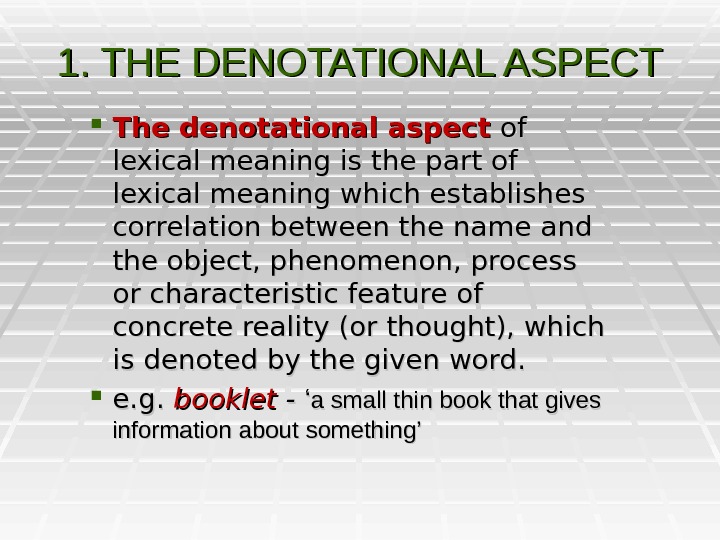
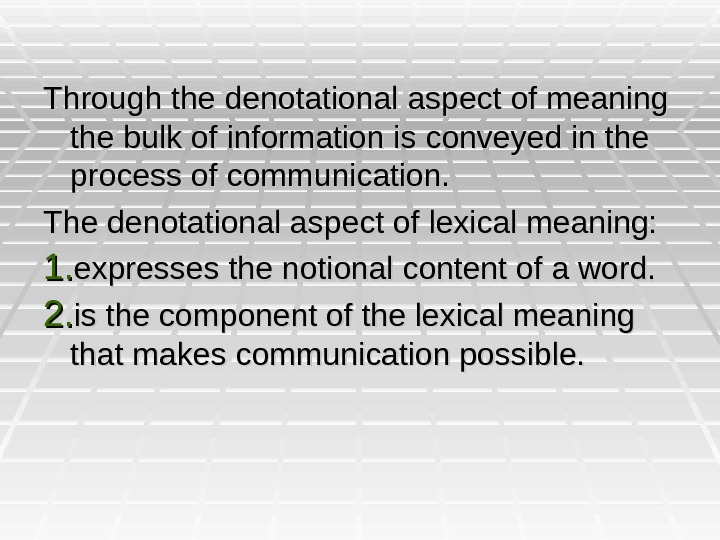


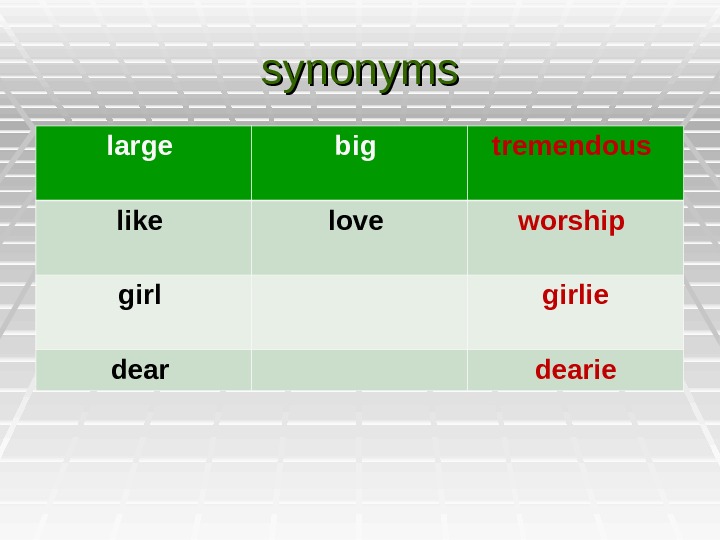
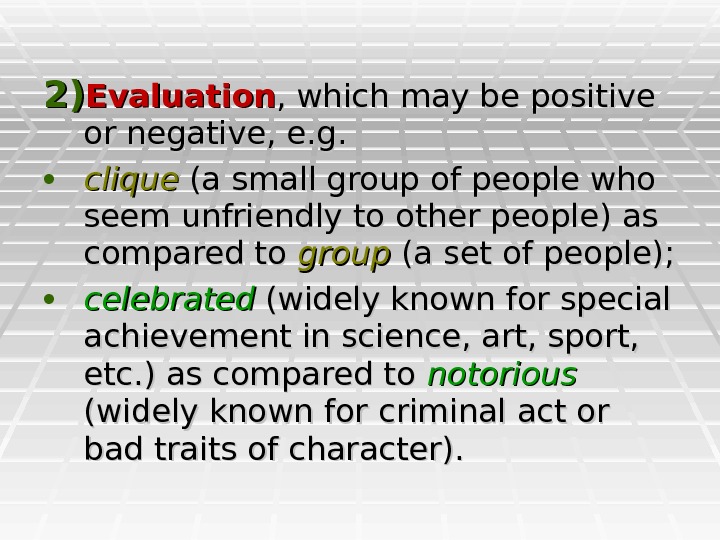
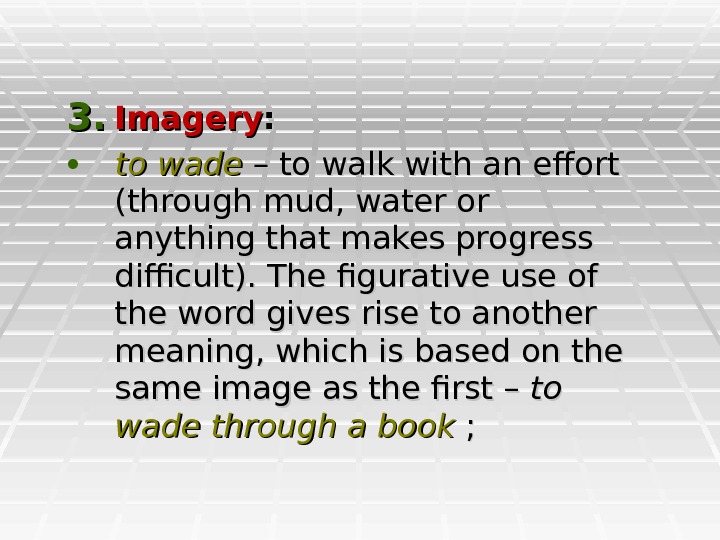
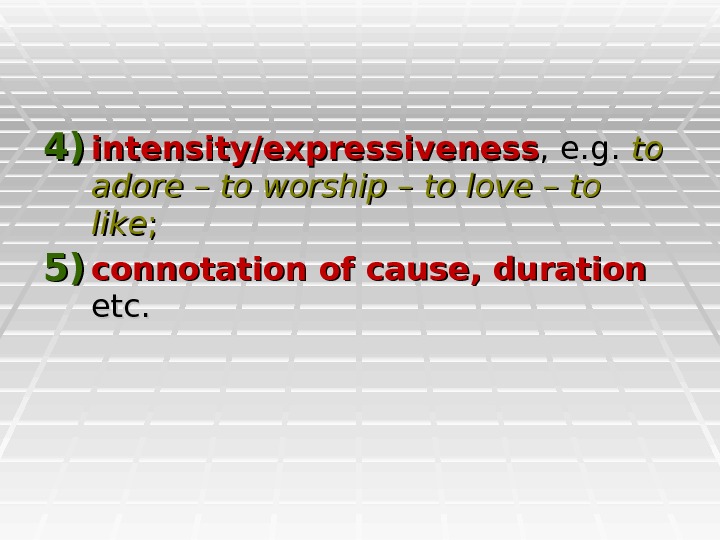



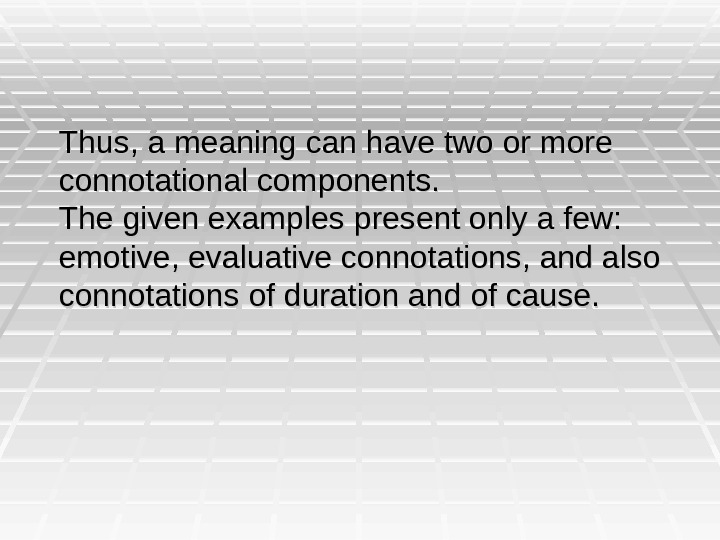




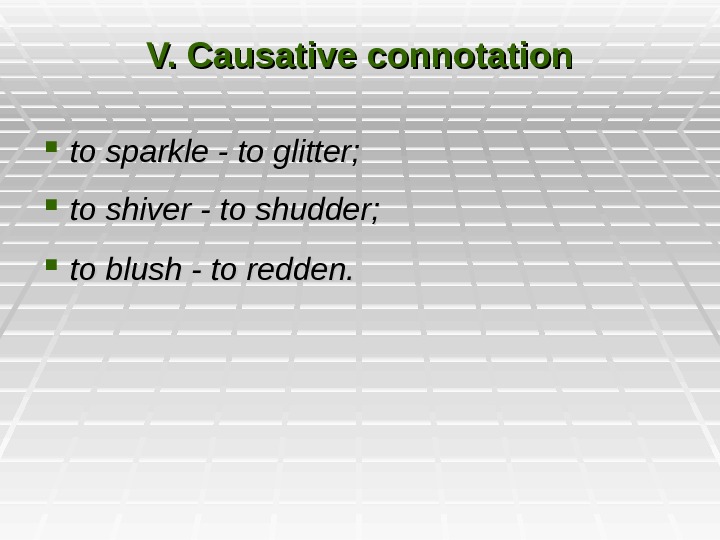
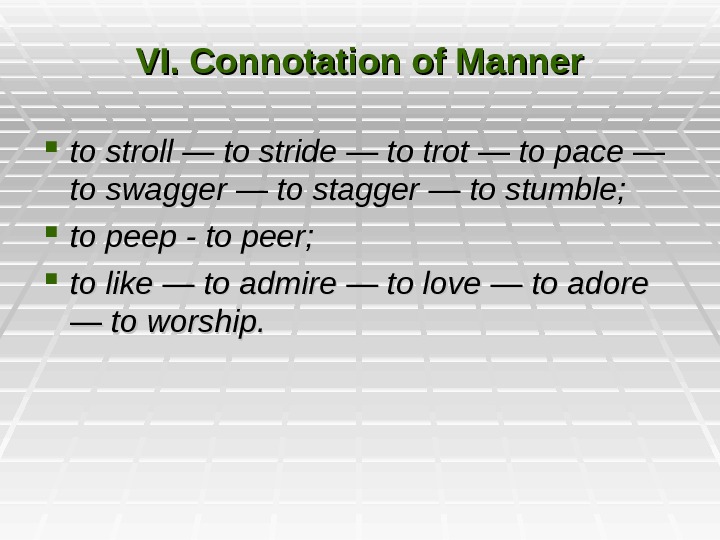
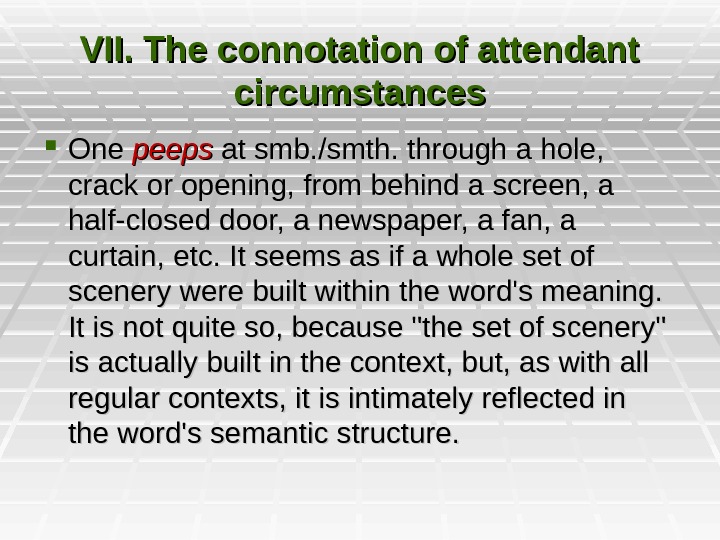
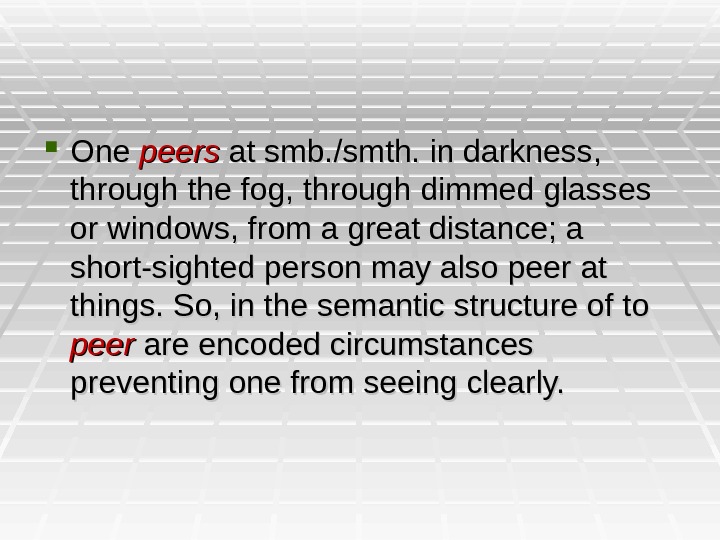

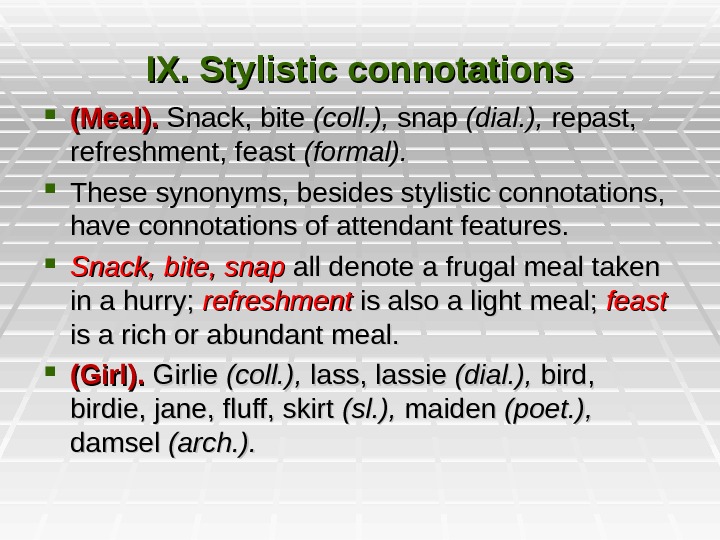




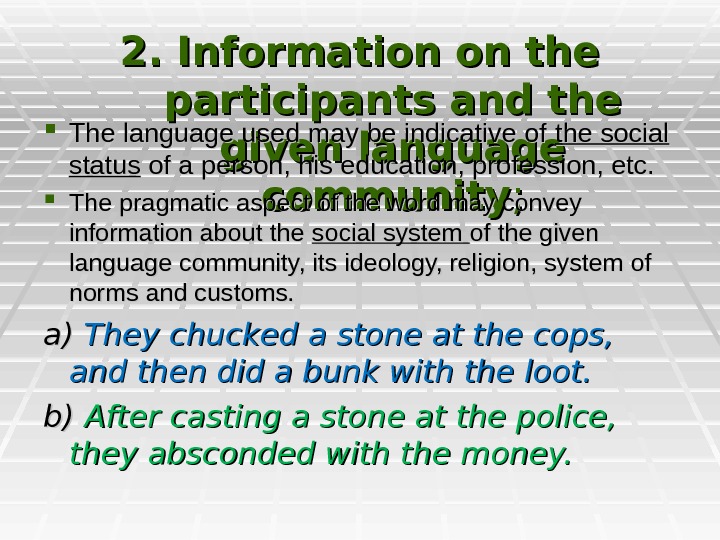

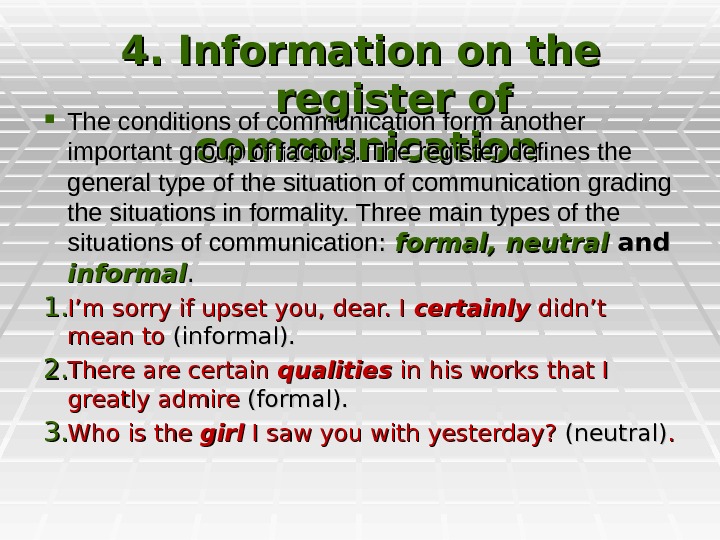
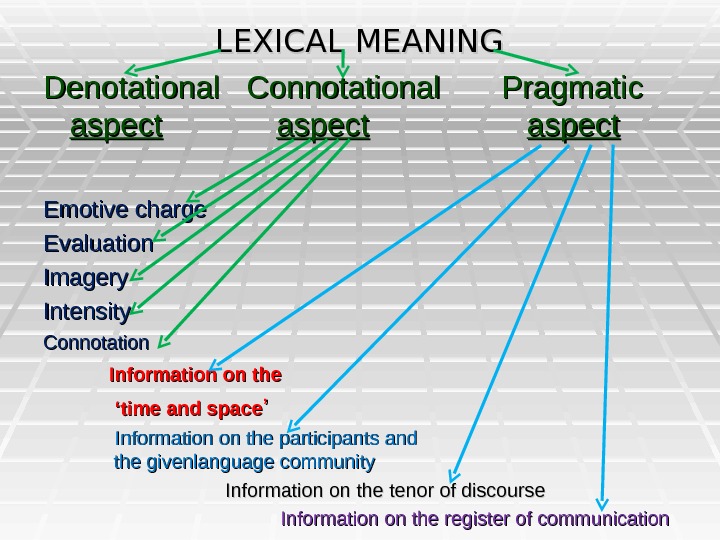
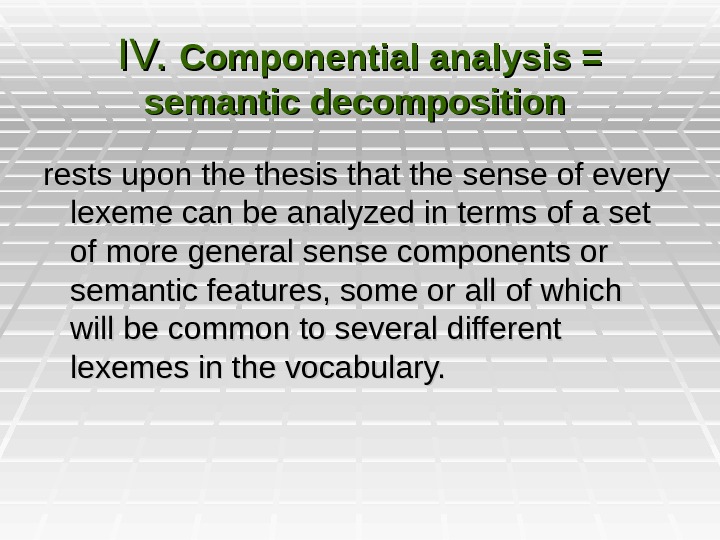
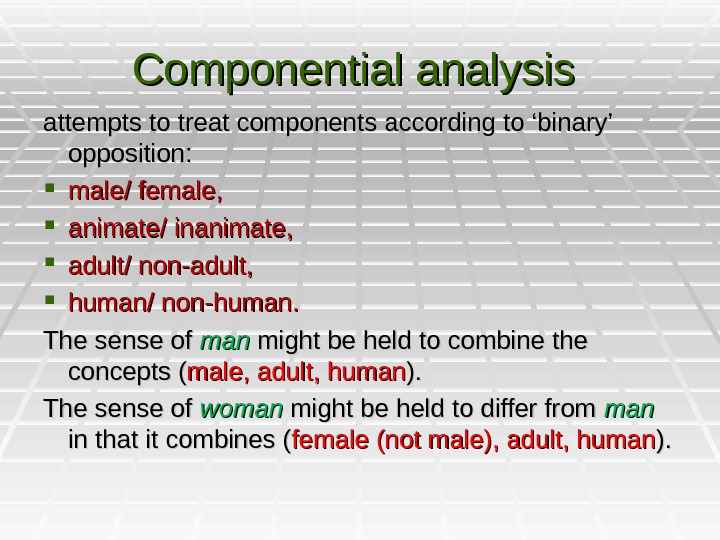
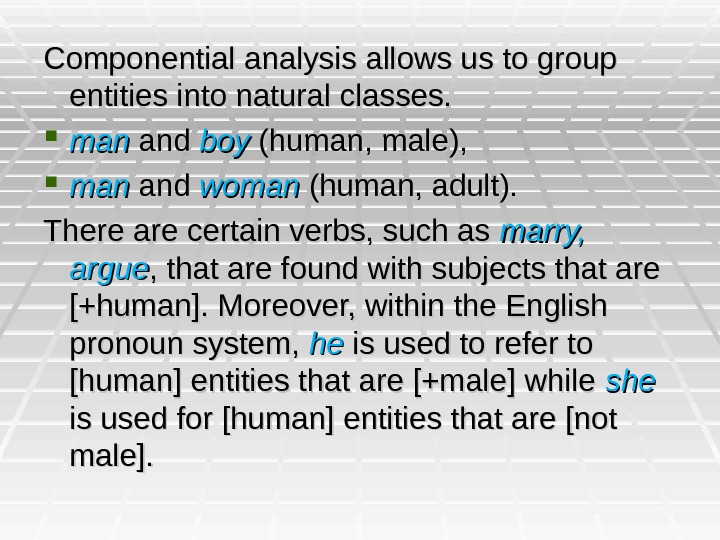

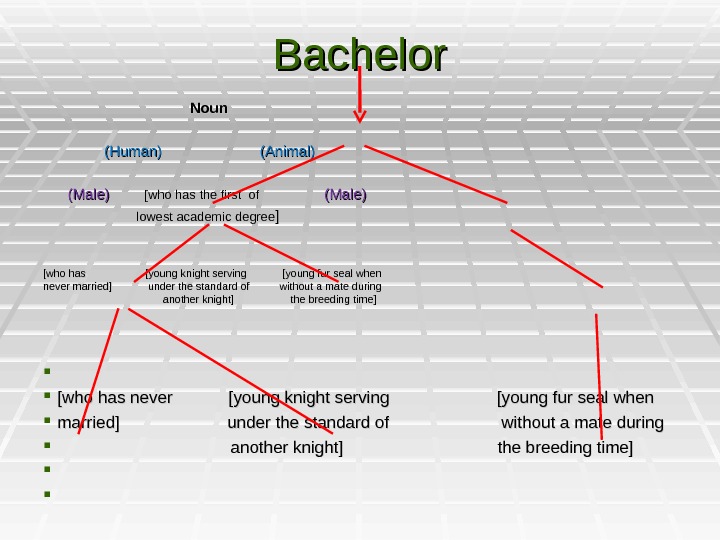
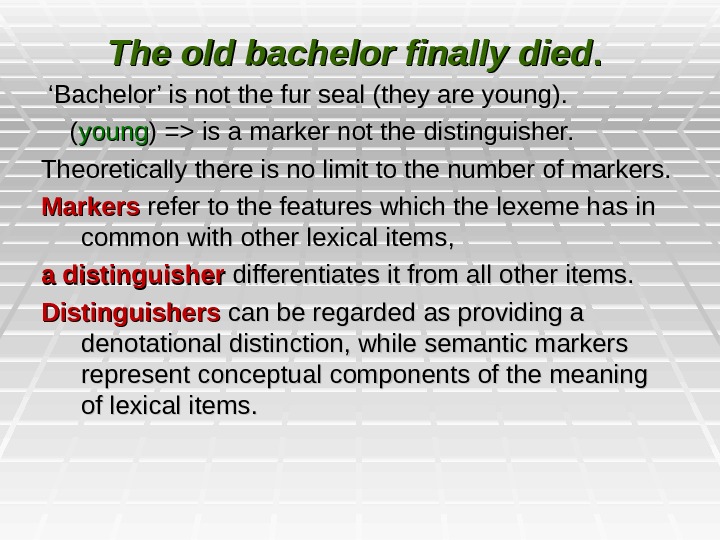
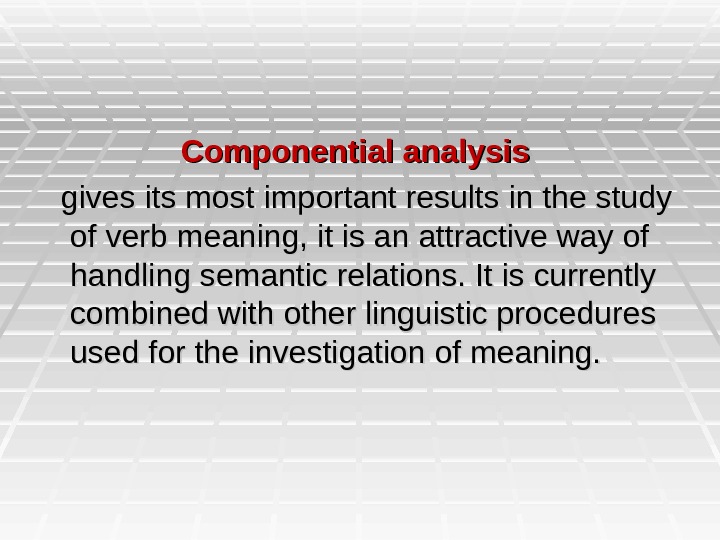
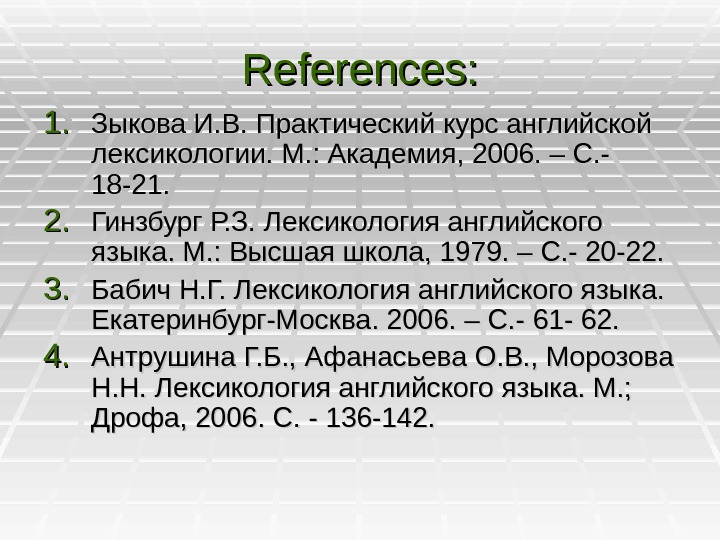
Слайд 1Aspects of Lexical Meaning
Lecture
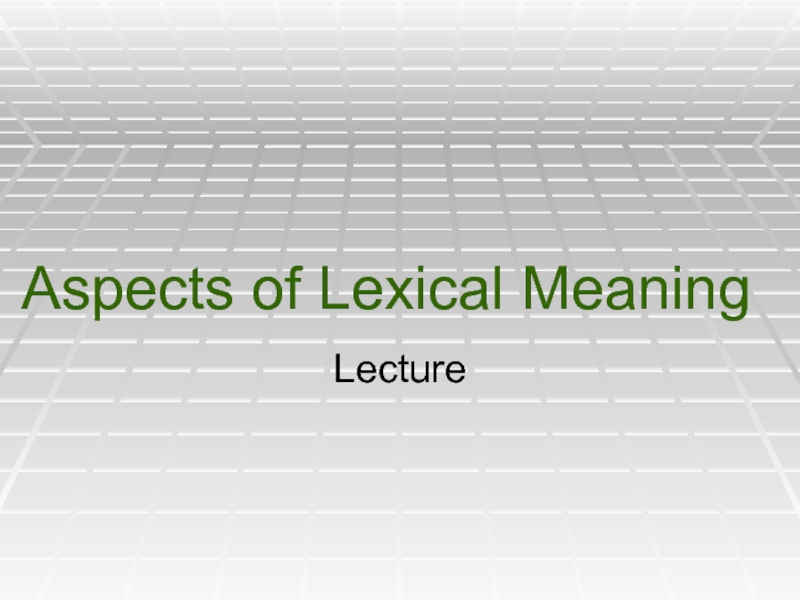
Слайд 2ASPECTS OF LEXICAL MEANING
THE DENOTATIONAL ASPECT
THE CONNOTATIONAL ASPECT
THE PRAGMATIC ASPECT
COMPONENTIAL ANALYSIS
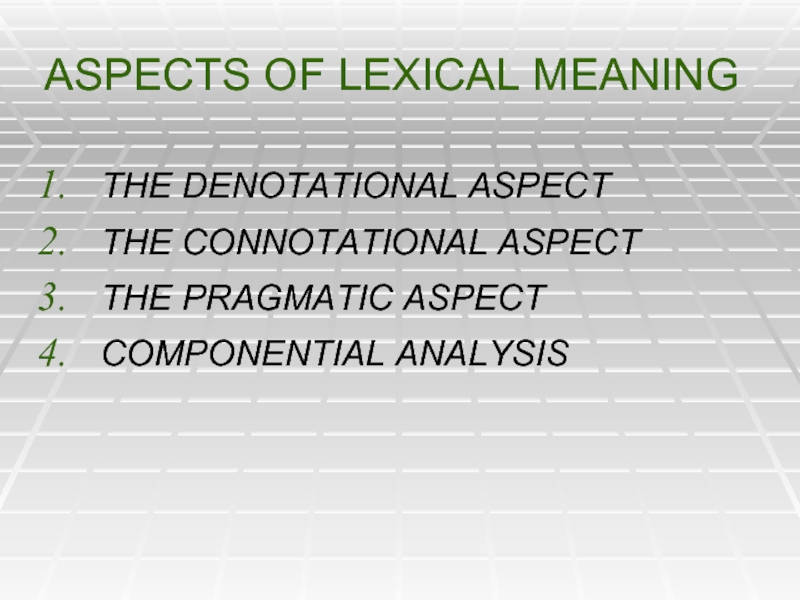
Слайд 31. THE DENOTATIONAL ASPECT
The denotational aspect of lexical meaning is the
part of lexical meaning which establishes correlation between the name and the object, phenomenon, process or characteristic feature of concrete reality (or thought), which is denoted by the given word.
e.g. booklet — ‘a small thin book that gives information about something’
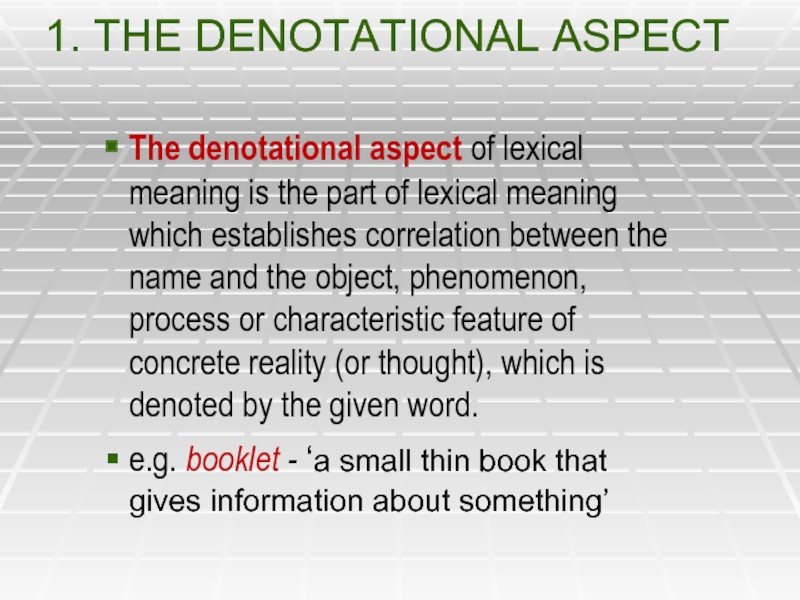
Слайд 4Through the denotational aspect of meaning the bulk of information is
conveyed in the process of communication.
The denotational aspect of lexical meaning:
expresses the notional content of a word.
is the component of the lexical meaning that makes communication possible.
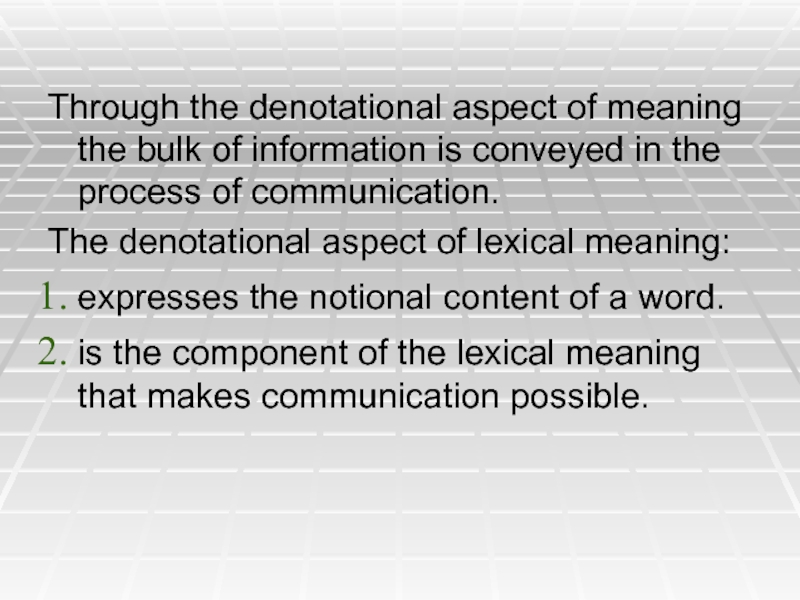
Слайд 52. THE CONNOTATIONAL ASPECT
The connotational aspect of lexical meaning is the
part of meaning which reflects the attitude of the speaker towards what he speaks about. Connotation conveys additional information in the process of communication.
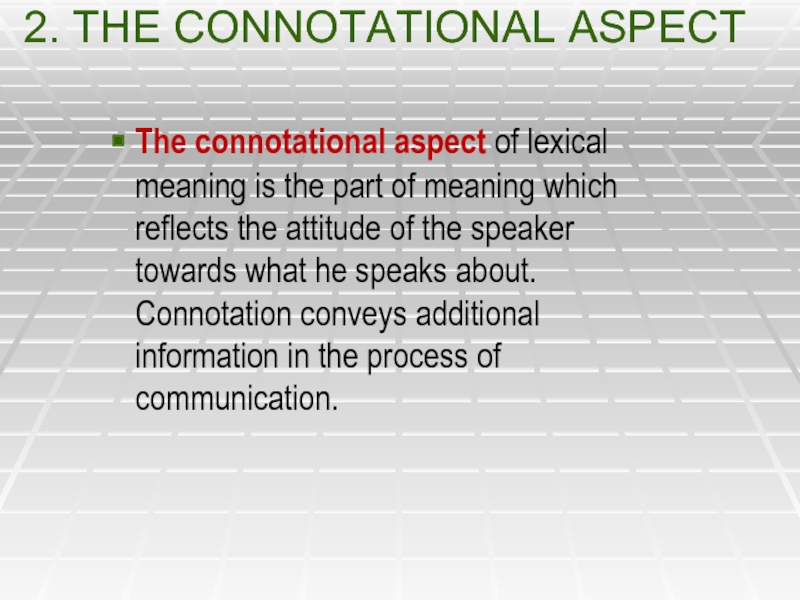
Слайд 6Connotation includes:
The emotive charge is one of the objective semantic features
proper to words as linguistic units and forms part of the connotational component of meaning, e.g. daddy as compared to father.
a hovel – ‘a small house or cottage’ – implies a miserable dwelling place, dirty, in bad repair and in general unpleasant to live in.
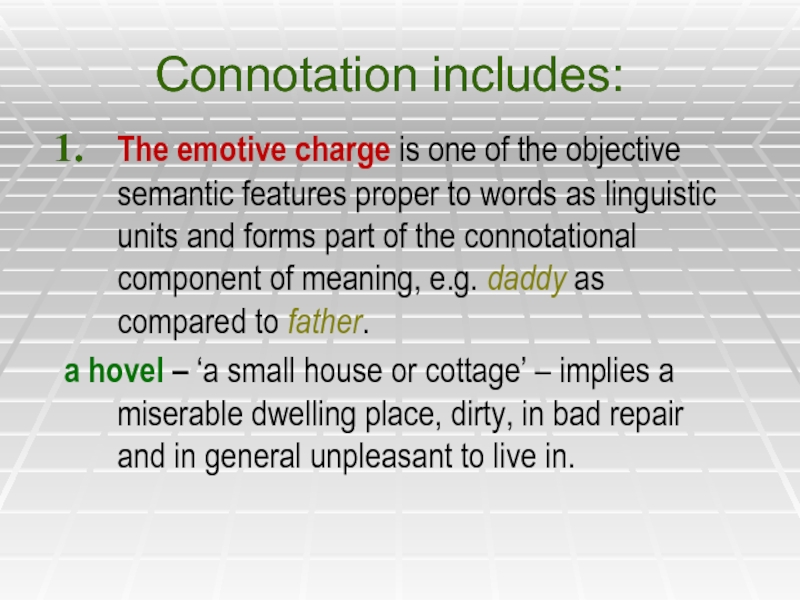
Слайд 8Evaluation, which may be positive or negative, e.g.
clique (a small
group of people who seem unfriendly to other people) as compared to group (a set of people);
celebrated (widely known for special achievement in science, art, sport, etc.) as compared to notorious (widely known for criminal act or bad traits of character).
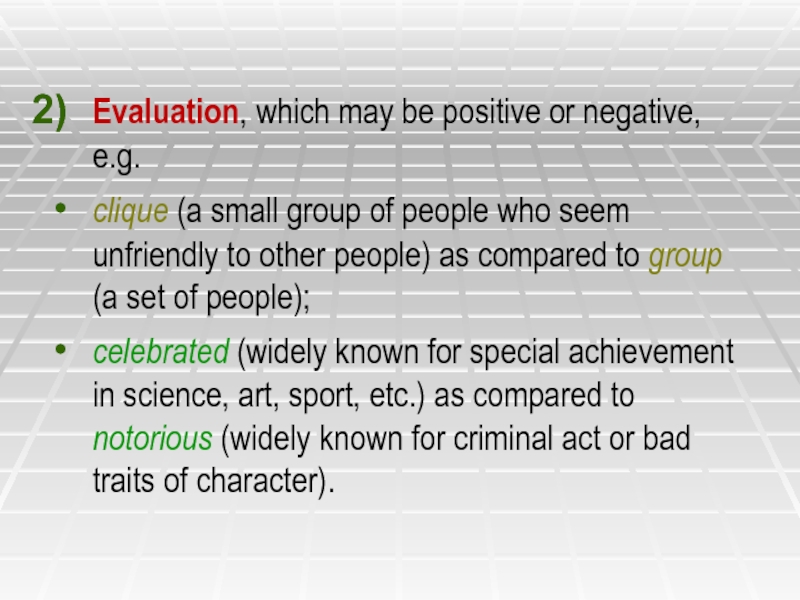
Слайд 9Imagery:
to wade – to walk with an effort (through mud,
water or anything that makes progress difficult). The figurative use of the word gives rise to another meaning, which is based on the same image as the first – to wade through a book ;
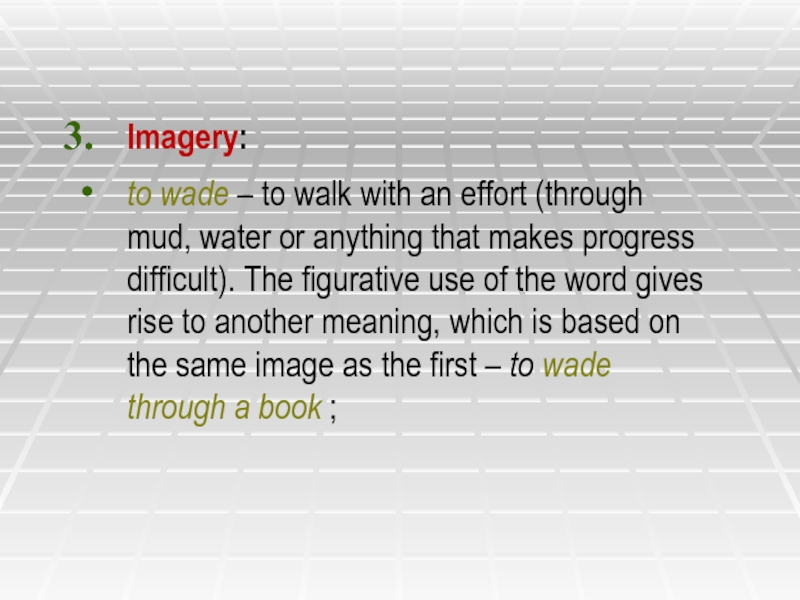
Слайд 10intensity/expressiveness, e.g. to adore – to worship – to love –
to like;
connotation of cause, duration etc.
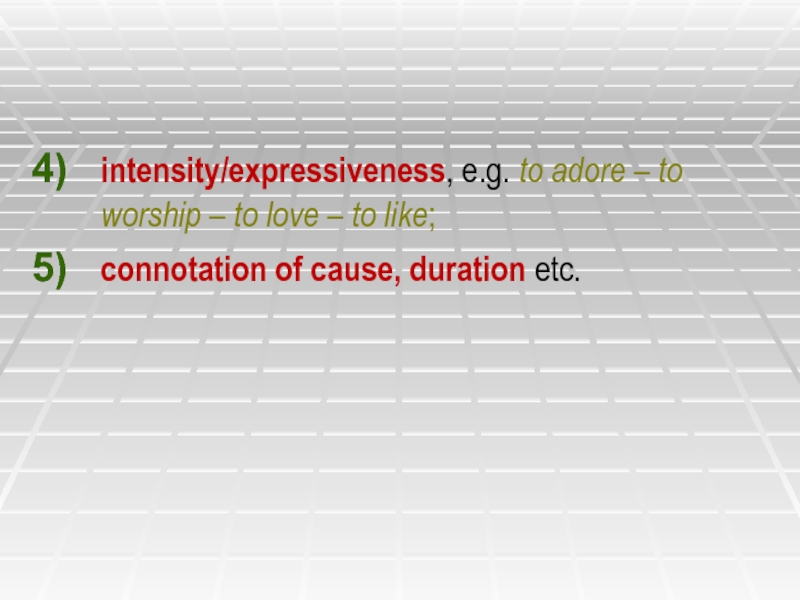
Слайд 14Thus, a meaning can have two or more connotational components.
The given
examples present only a few: emotive, evaluative connotations, and also connotations of duration and of cause.
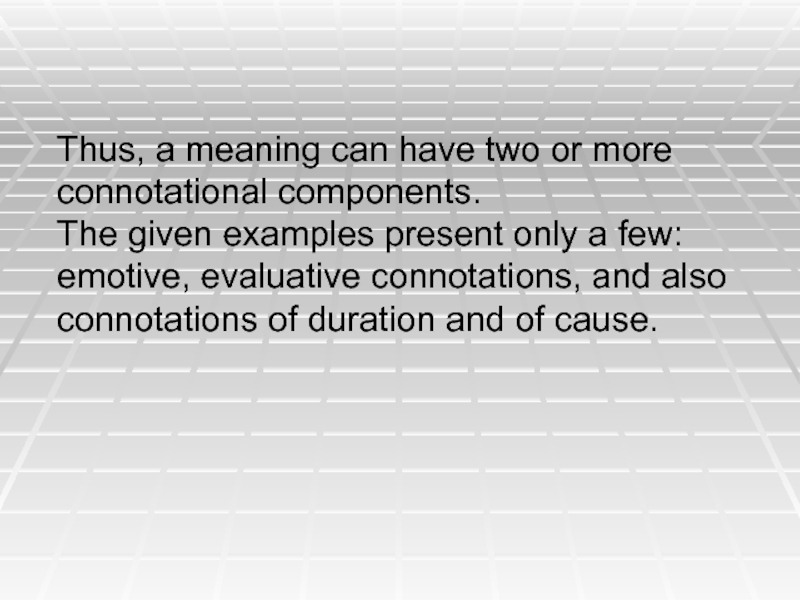
Слайд 153. Examples of different types of Connotation
I. The connotation of degree
or intensity
to surprise — to astonish — to amaze — to astound;
to satisfy — to please — to content — to gratify — to delight — to exalt;
to shout — to yell — to bellow — to roar; to like — to admire — to love — to adore — to worship
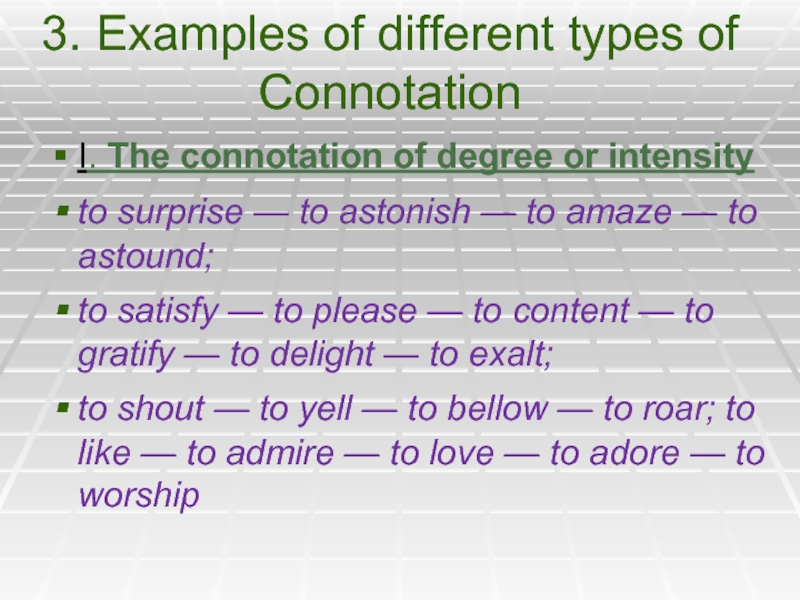
Слайд 16II. Connotation of duration
to stare — to glare — to gaze
— to glance — to peep — to peer;
to flash (brief) — to blaze (lasting);
to shudder (brief) — to shiver (lasting);
to say (brief) — to speak, to talk (lasting).
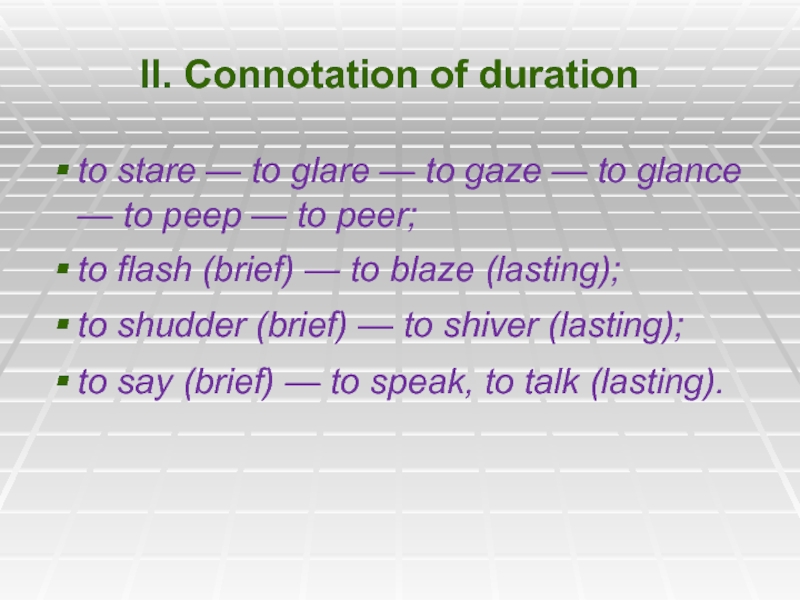
Слайд 17III. Emotive connotations
to stare — to glare — to gaze;
alone —
single — lonely — solitary;
to tremble — to shiver — to shudder — to shake;
to love — to admire — to adore — to worship;
angry — furious — enraged;
fear — terror — horror.
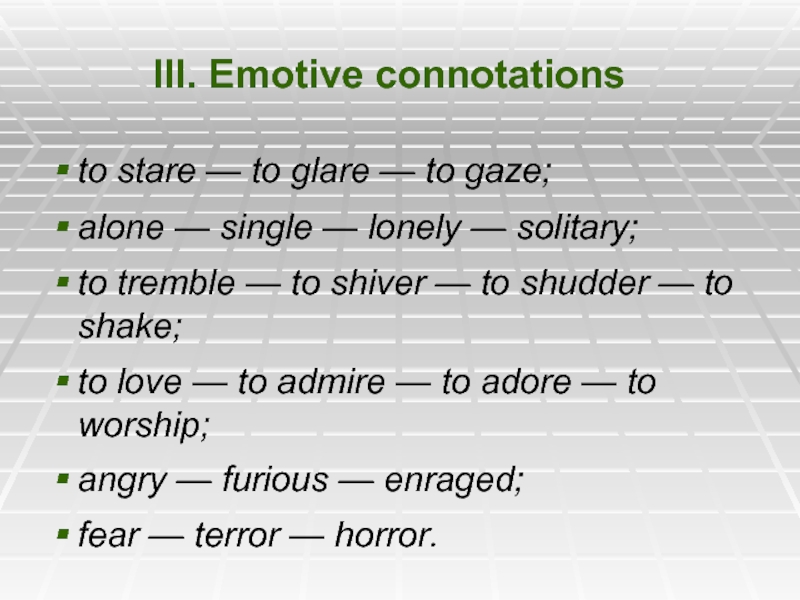
Слайд 18IV. The evaluative connotation
well-known — famous — notorious — celebrated;
to produce
— to create — to manufacture — to fabricate;
to sparkle — to glitter;
A. His (her) eyes sparkled with amusement, merriment, good humour, high spirits, happiness, etc. (positive emotions).
B. His (her) eyes glittered with anger, rage, hatred,
malice, etc. (negative emotions).
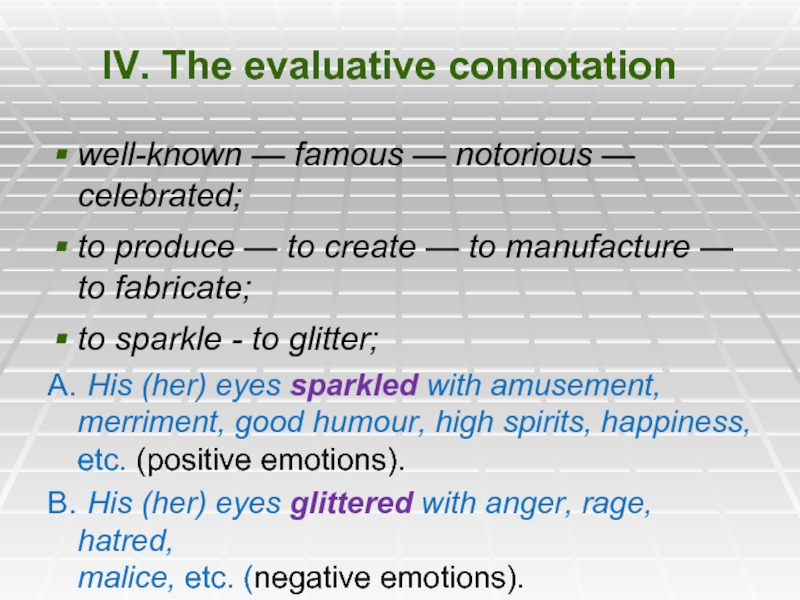
Слайд 19V. Causative connotation
to sparkle — to glitter;
to shiver — to shudder;
to
blush — to redden.
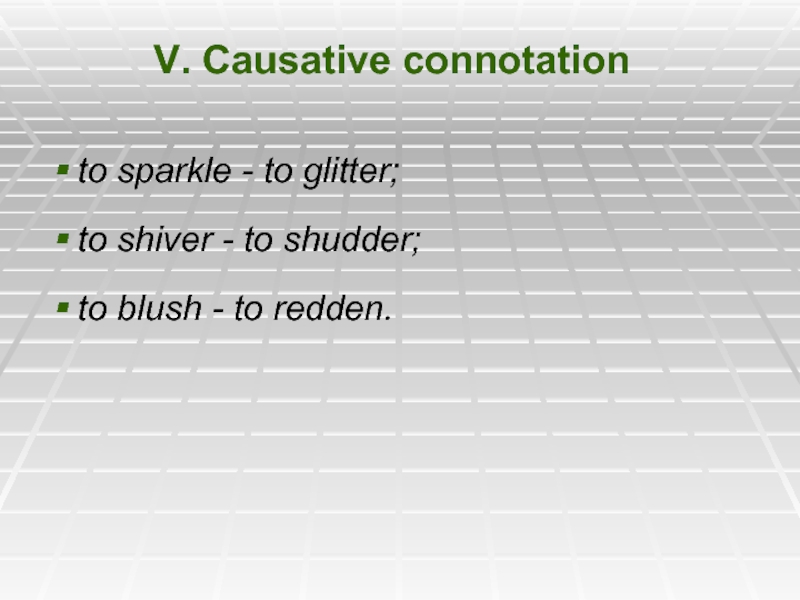
Слайд 20VI. Connotation of Manner
to stroll — to stride — to trot
— to pace — to swagger — to stagger — to stumble;
to peep — to peer;
to like — to admire — to love — to adore — to worship.
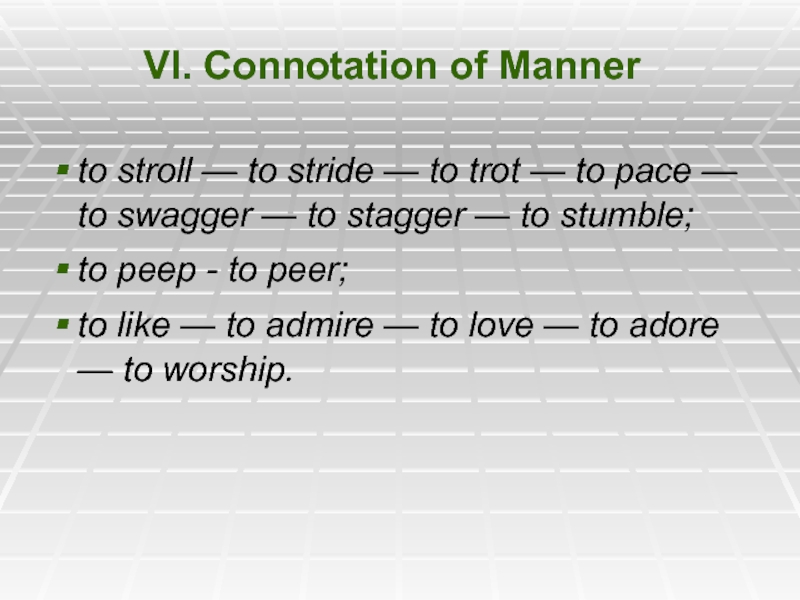
Слайд 21VII. The connotation of attendant circumstances
One peeps at smb./smth. through a
hole, crack or opening, from behind a screen, a half-closed door, a newspaper, a fan, a curtain, etc. It seems as if a whole set of scenery were built within the word’s meaning. It is not quite so, because «the set of scenery» is actually built in the context, but, as with all regular contexts, it is intimately reflected in the word’s semantic structure.
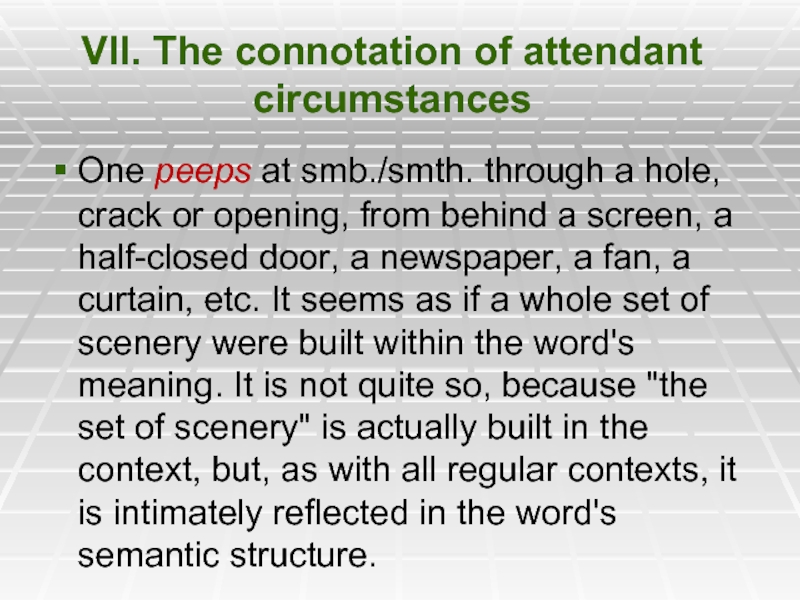
Слайд 22One peers at smb./smth. in darkness, through the fog, through dimmed
glasses or windows, from a great distance; a short-sighted person may also peer at things. So, in the semantic structure of to peer are encoded circumstances preventing one from seeing clearly.
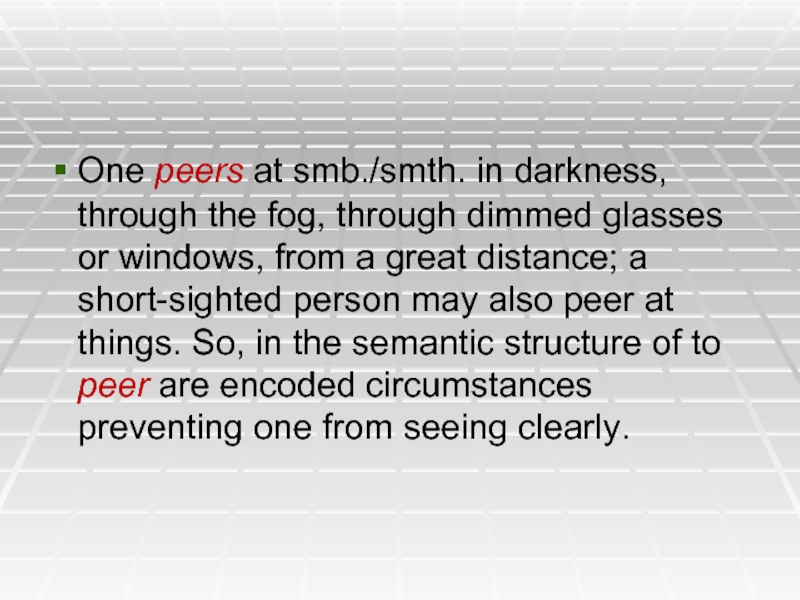
Слайд 23VII. Connotation of attendant features
Pretty – handsome – beautiful;
special types
of human beauty:
beautiful is mostly associated with classical features and a perfect figure;
handsome with a tall stature, a certain robustness and fine proportions,
pretty with small delicate features and a fresh complexion.
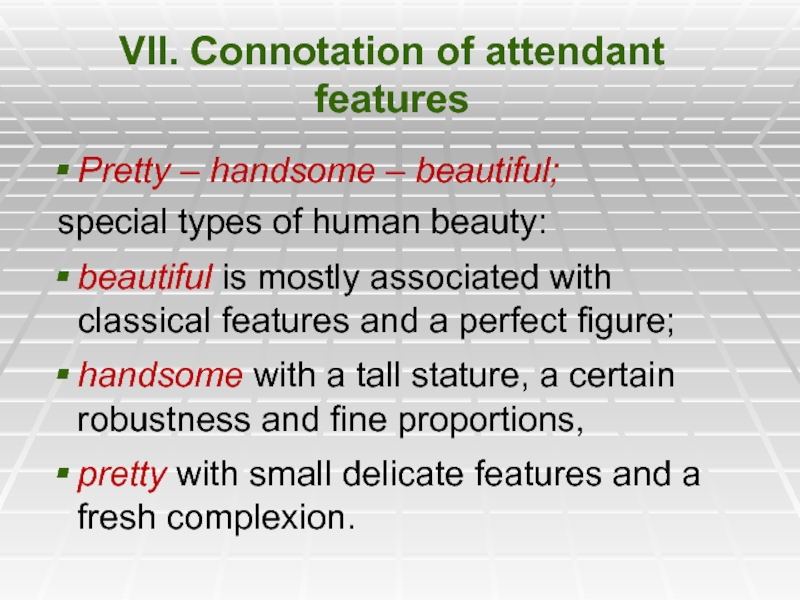
Слайд 24IX. Stylistic connotations
(Meal). Snack, bite (coll.), snap (dial.), repast, refreshment, feast
(formal).
These synonyms, besides stylistic connotations, have connotations of attendant features.
Snack, bite, snap all denote a frugal meal taken in a hurry; refreshment is also a light meal; feast is a rich or abundant meal.
(Girl). Girlie (coll.), lass, lassie (dial.), bird, birdie, jane, fluff, skirt (sl.), maiden (poet.), damsel (arch.).
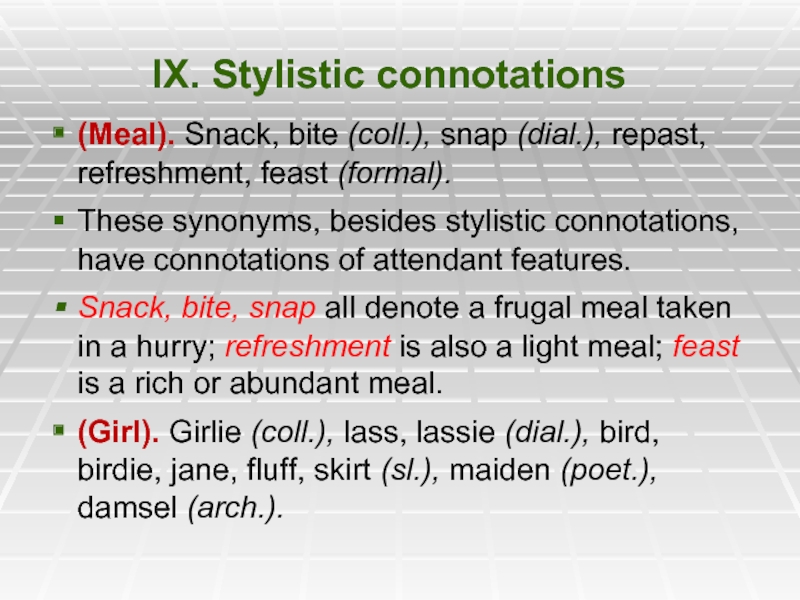
Слайд 25Anecdote
J a n e: Would you be insulted if that
good-looking stranger offered you some champagne?
J o a n: Yes, but I’d probably swallow the insult.
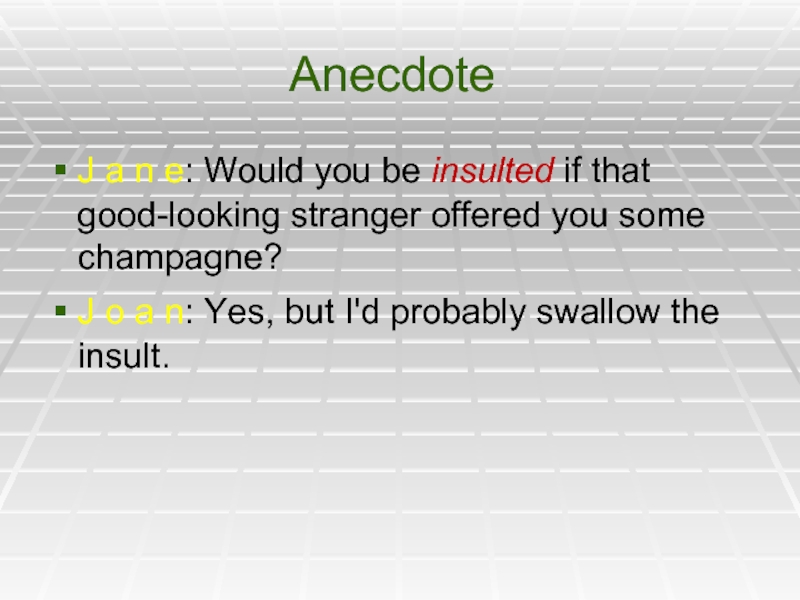
Слайд 263. THE PRAGMATIC ASPECT
The pragmatic aspect is the part of lexical
meaning that conveys information on the situation of communication. Like the connotational aspect, the pragmatic aspect falls into four closely linked together subsections.
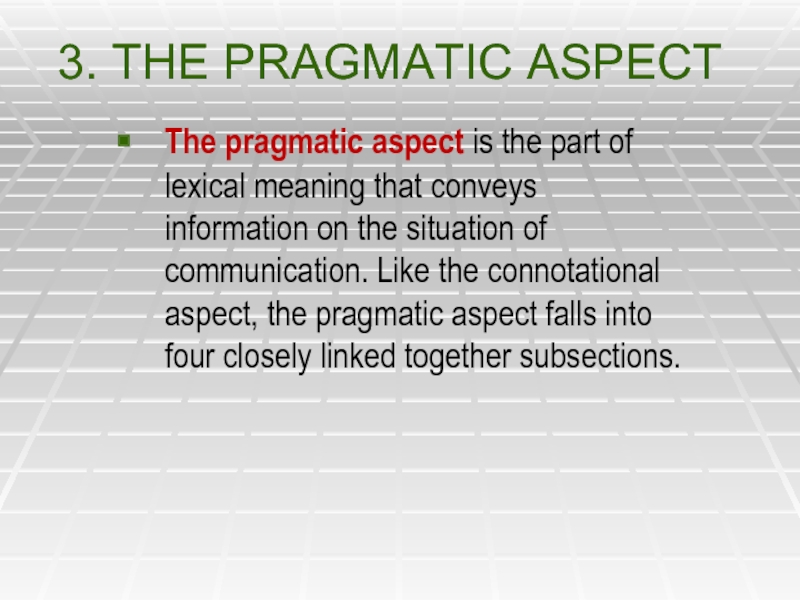
Слайд 27
1. Information on the ‘time and space’ relationship of the participants
Some
information which specifies different parameters of communication may be conveyed not only with the help of grammatical means (tense forms, personal pronouns, etc), but through the meaning of the word.
E.g. come and go can indicate the location of the speaker who is usually taken as the zero point in the description of the situation of communication
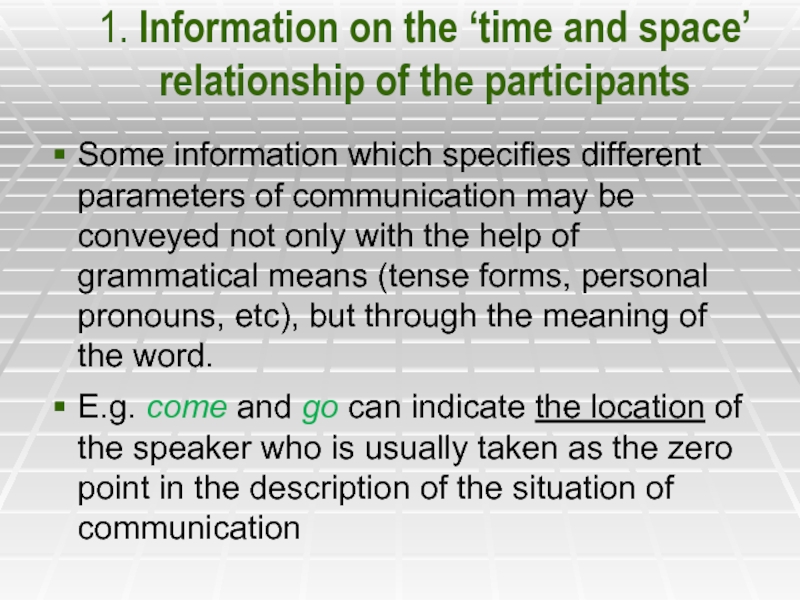
Слайд 28The time element is fixed indirectly. Indirect reference to time implies
that the frequency of occurrence of words may change with time and in extreme cases words may be out of use or become obsolete.
E.g.the word behold – ‘take notice, see (smth unusual)’ as well as the noun beholder – ‘spectator’ are out of use now but were widely used in the 17th century.
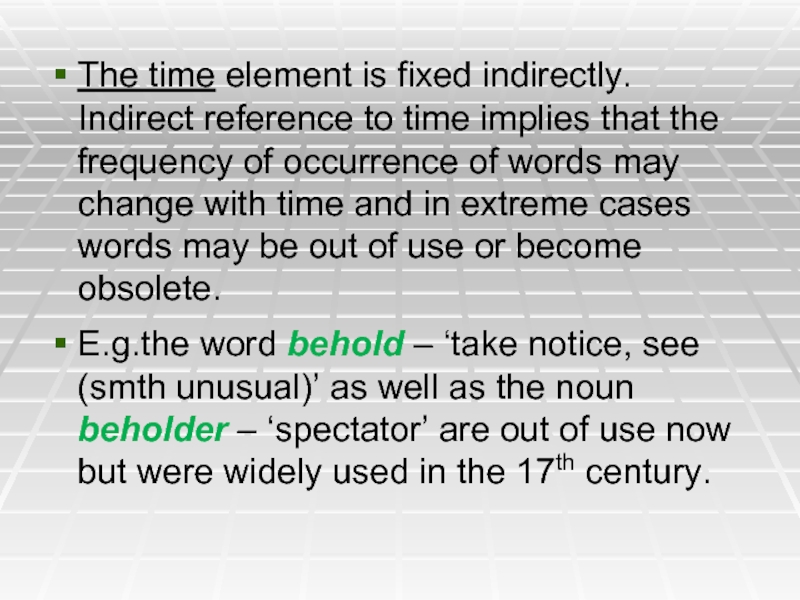
Слайд 292. Information on the participants and the given language community;
The language
used may be indicative of the social status of a person, his education, profession, etc.
The pragmatic aspect of the word may convey information about the social system of the given language community, its ideology, religion, system of norms and customs.
a) They chucked a stone at the cops, and then did a bunk with the loot.
b) After casting a stone at the police, they absconded with the money.
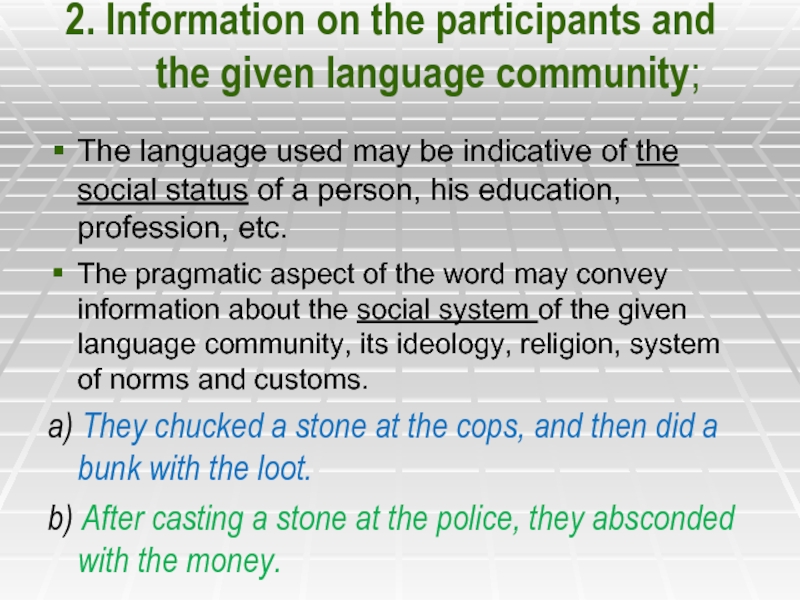
Слайд 303. Information on the tenor of discourse
The tenors of discourse reflect
how the addresser (the speaker or the writer) interacts with the addressee (the listener or reader).
Tenors are based on social or family roles of the participants of communication.
1. Don’t interrupt when your mother is speaking (family roles).
2. There is an awful man in the front row, who butts in whenever you pause (social roles).
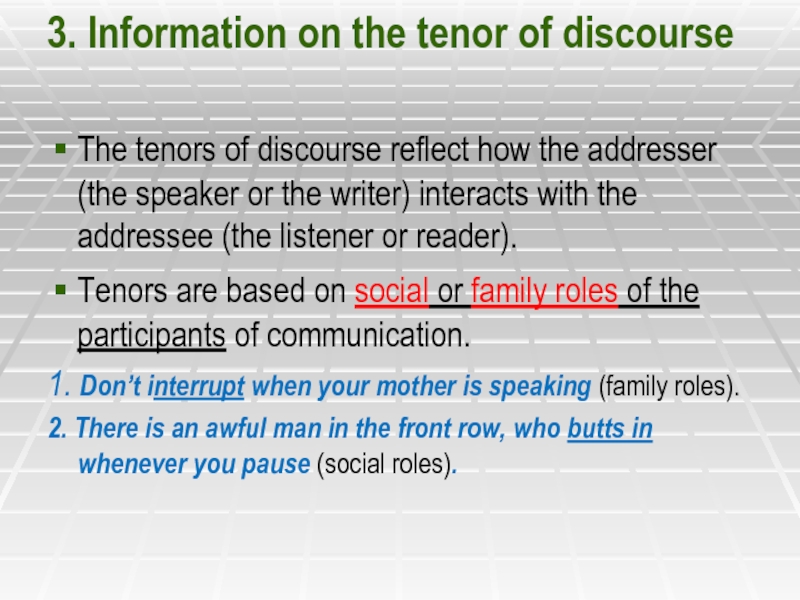
Слайд 314. Information on the register of communication
The conditions of
communication form another important group of factors. The register defines the general type of the situation of communication grading the situations in formality. Three main types of the situations of communication: formal, neutral and informal.
I’m sorry if upset you, dear. I certainly didn’t mean to (informal).
There are certain qualities in his works that I greatly admire (formal).
Who is the girl I saw you with yesterday? (neutral).

Слайд 32LEXICAL MEANING
Denotational Connotational Pragmatic aspect
aspect aspect
Emotive charge
Evaluation
Imagery
Intensity
Connotation
Information on the
‘time and space’
Information on the participants and
the givenlanguage community
Information on the tenor of discourse
Information on the register of communication
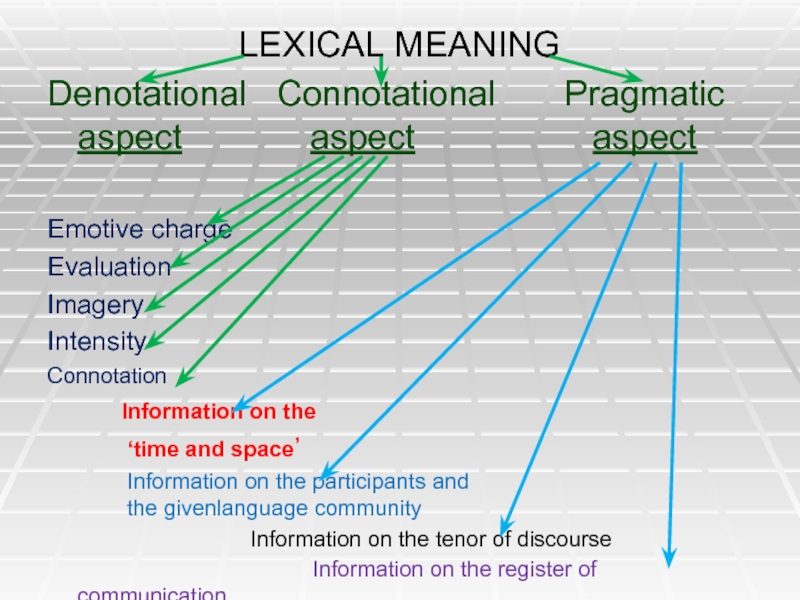
Слайд 33IV. Componential analysis = semantic decomposition
rests upon the thesis that
the sense of every lexeme can be analyzed in terms of a set of more general sense components or semantic features, some or all of which will be common to several different lexemes in the vocabulary.
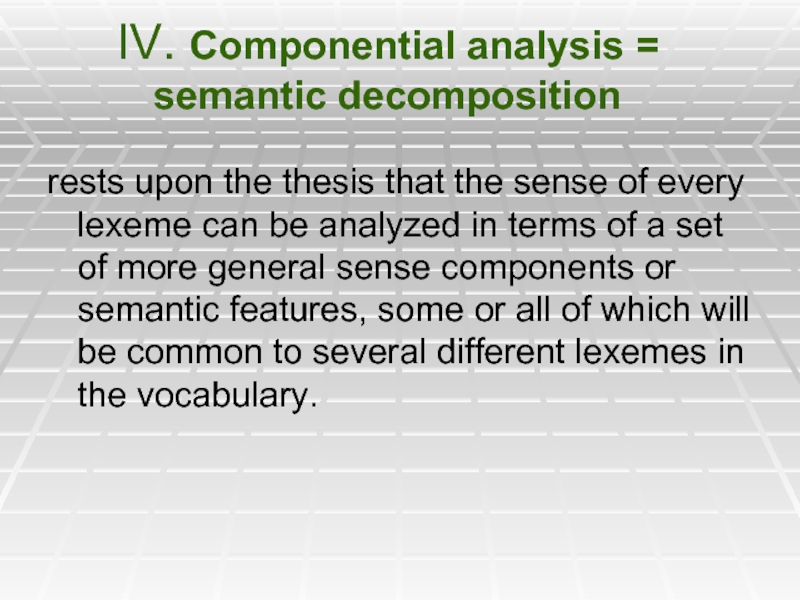
Слайд 34Componential analysis
attempts to treat components according to ‘binary’ opposition:
male/
female,
animate/ inanimate,
adult/ non-adult,
human/ non-human.
The sense of man might be held to combine the concepts (male, adult, human).
The sense of woman might be held to differ from man in that it combines (female (not male), adult, human).
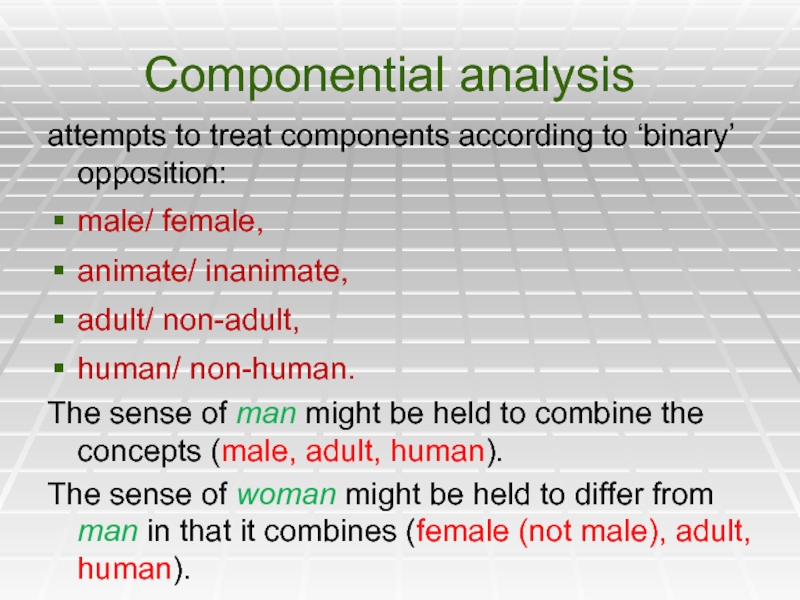
Слайд 35Componential analysis allows us to group entities into natural classes.
man
and boy (human, male),
man and woman (human, adult).
There are certain verbs, such as marry, argue, that are found with subjects that are [+human]. Moreover, within the English pronoun system, he is used to refer to [human] entities that are [+male] while she is used for [human] entities that are [not male].
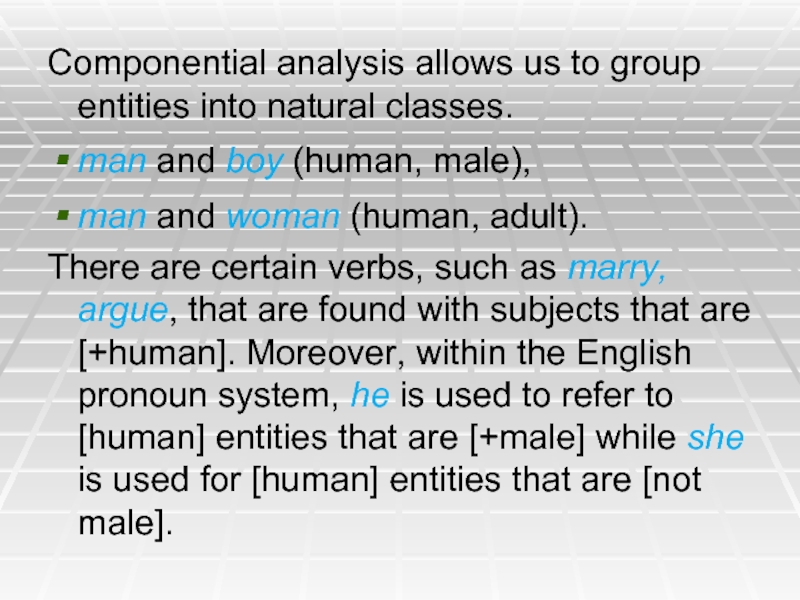
Слайд 36Componential analysis of the word ‘bachelor’
According to the dictionary it has
4 meanings:
a man who has never married (холостяк);
a young knight (рыцарь);
someone with a first degree (бакалавр);
a young male unmated fur seal (морской котик) during the mating season.
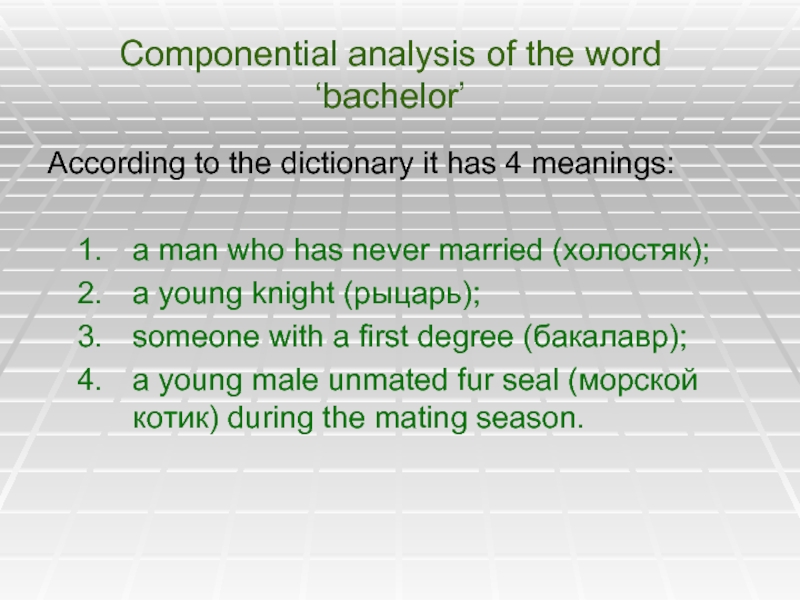
Слайд 37Bachelor
Noun
(Human) (Animal)
(Male) [who has the first of (Male)
lowest academic degree]
[who has [young knight serving [young fur seal when
never married] under the standard of without a mate during
another knight] the breeding time]
[who has never [young knight serving [young fur seal when
married] under the standard of without a mate during
another knight] the breeding time]
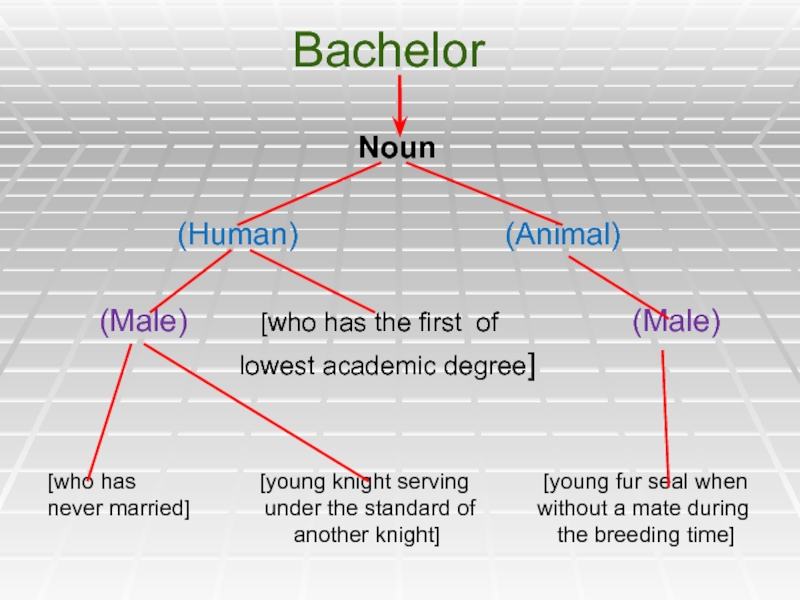
Слайд 38The old bachelor finally died.
‘Bachelor’ is not the fur
seal (they are young).
(young) => is a marker not the distinguisher.
Theoretically there is no limit to the number of markers.
Markers refer to the features which the lexeme has in common with other lexical items,
a distinguisher differentiates it from all other items.
Distinguishers can be regarded as providing a denotational distinction, while semantic markers represent conceptual components of the meaning of lexical items.
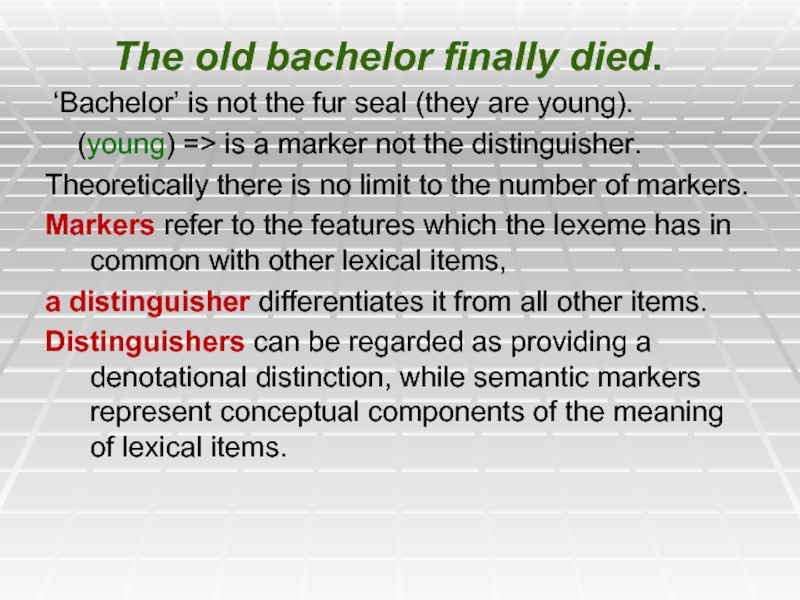
Слайд 39Componential analysis
gives its most important results in the study
of verb meaning, it is an attractive way of handling semantic relations. It is currently combined with other linguistic procedures used for the investigation of meaning.
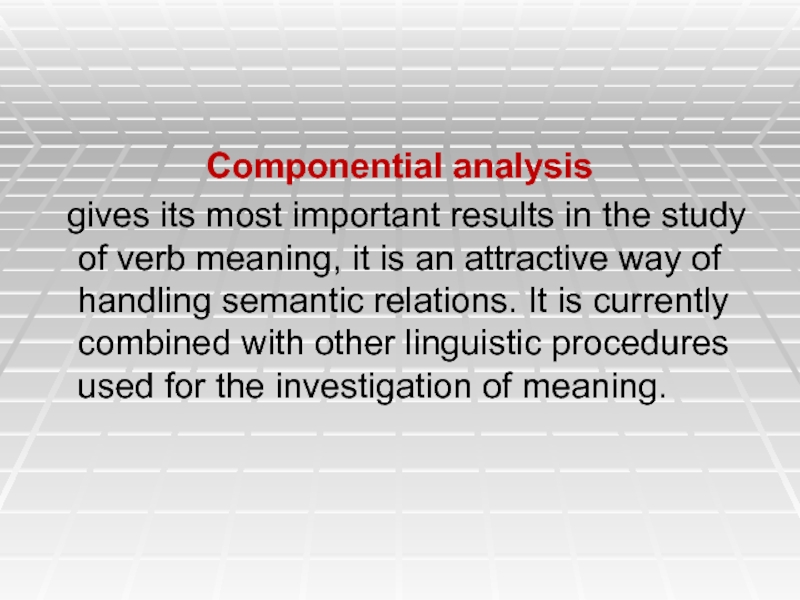
Слайд 40References:
Зыкова И.В. Практический курс английской лексикологии. М.: Академия, 2006. – С.-
18-21.
Гинзбург Р.З. Лексикология английского языка. М.: Высшая школа, 1979. – С.- 20-22.
Бабич Н.Г. Лексикология английского языка. Екатеринбург-Москва. 2006. – С.- 61- 62.
Антрушина Г.Б., Афанасьева О.В., Морозова Н.Н. Лексикология английского языка. М.; Дрофа, 2006. С. — 136-142.








































